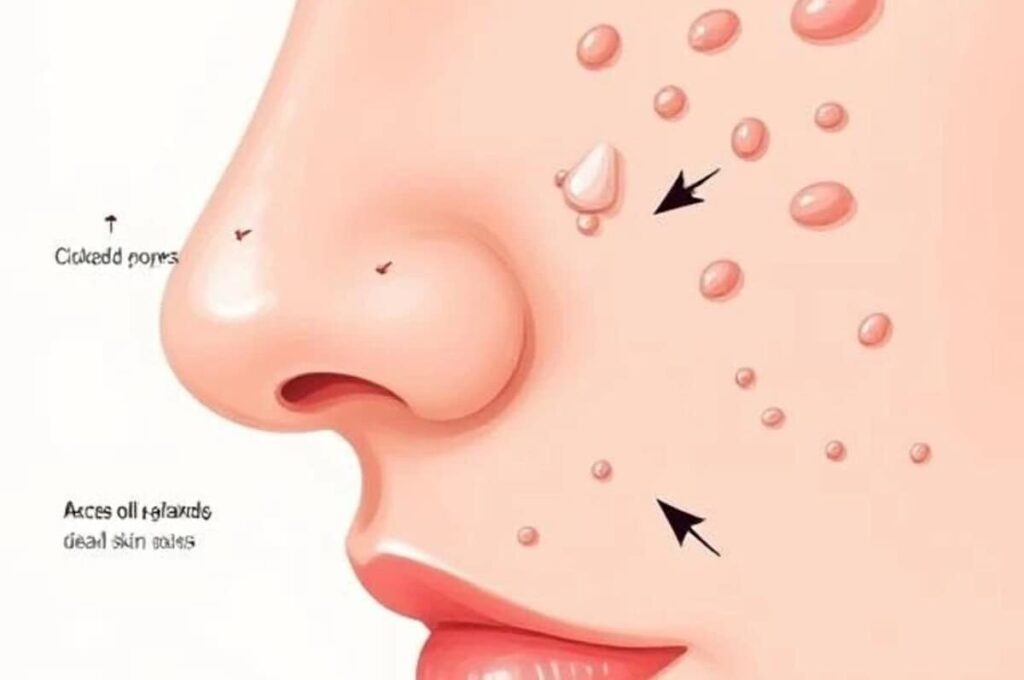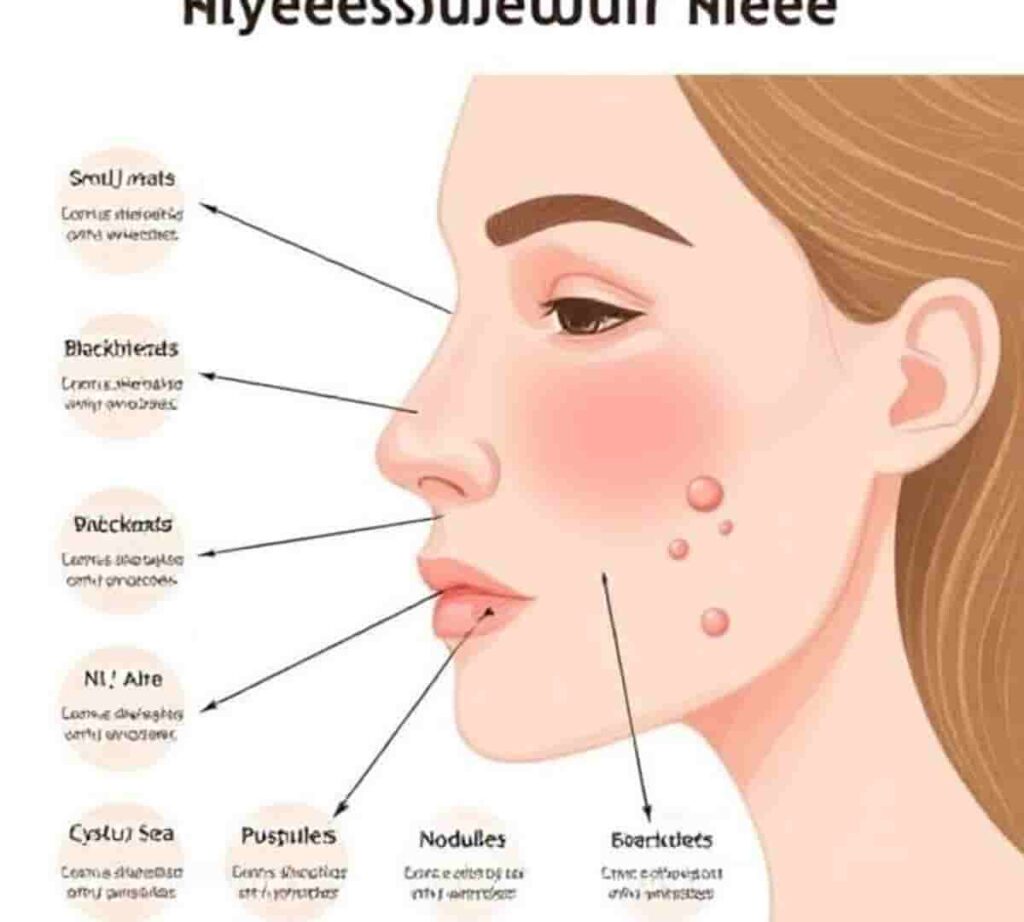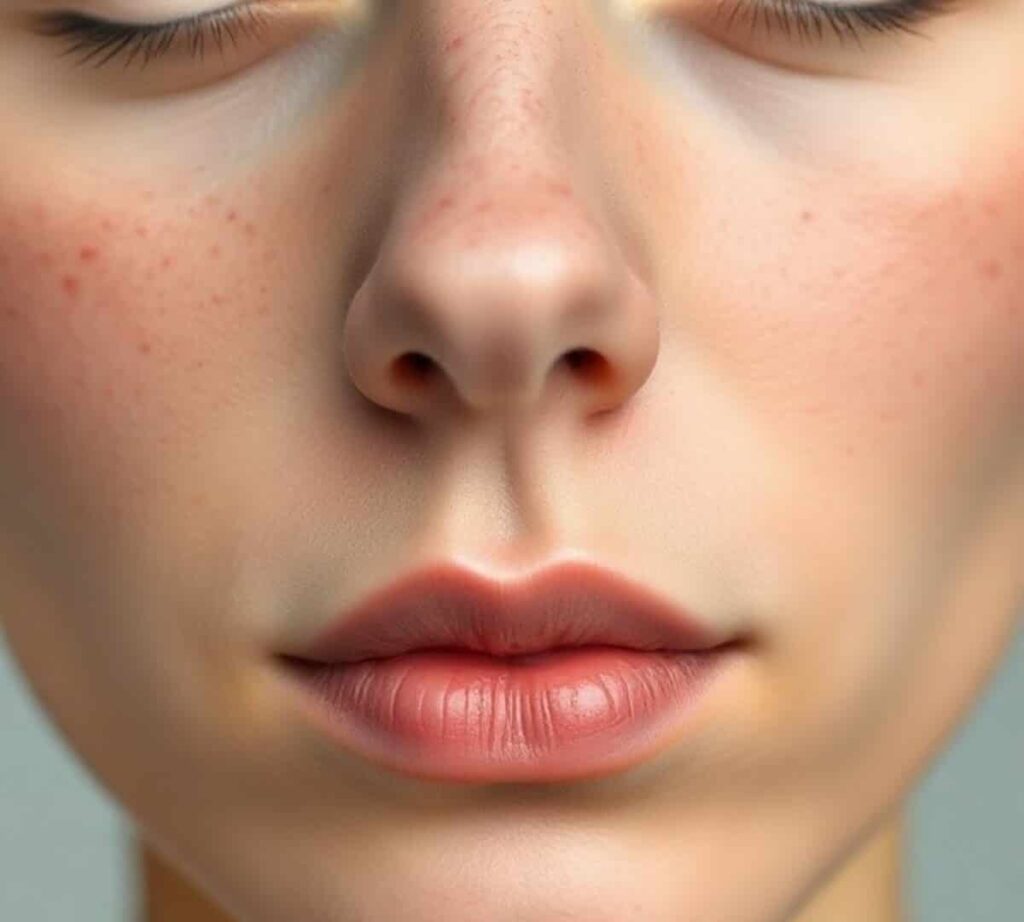Acne Around Nose: Causes, Types, Treatments, and Prevention
Introduction
Acne is one of the most common skin conditions worldwide, and while it can appear anywhere on the face, acne around nose is particularly frustrating. The nose and the surrounding area (the so-called “T-zone”) is naturally oily, making it more prone to breakouts. For many people, pimples around the nose can be persistent, painful, and sometimes even embarrassing.
If you have ever wondered:
- “Why do I always get pimples around my nose?”
- “What is the best way to treat acne around nose?”
- “How can I prevent nose acne from coming back?”
…then this guide is for you.
In this detailed article, we will explore the causes, types, effective treatments, and prevention methods for acne around the nose, along with expert tips and natural remedies you can try at home.
Causes of Acne Around Nose
Acne never happens without a reason. Understanding why nose pimples develop is the first step to controlling them. Here are the most common causes:

1. Excess Sebum (Oil) Production
The skin around the nose has more sebaceous glands compared to other areas of the face. These glands produce sebum (oil) to keep the skin moisturized. However, when sebum production becomes excessive, it clogs the pores, leading to blackheads, whiteheads, and inflammatory pimples. This is the leading cause of acne around nose.
2. Hormonal Changes
Hormones directly influence oil production. During puberty, menstrual cycles, pregnancy, or even periods of high stress, hormonal fluctuations can overstimulate sebaceous glands. This explains why teenagers and young adults often complain of persistent acne around the nose and chin area.
3. Poor Hygiene and Dirt Buildup
Your nose is constantly exposed to dust, sweat, and pollution. If you don’t wash your face properly, dirt and dead skin cells accumulate in the pores. Additionally, frequently touching your face or using a dirty mobile phone against your skin can transfer bacteria, worsening nose pimples.
4. Diet and Lifestyle Factors
Your diet plays a bigger role in acne than you might think. Diets high in refined sugar, dairy products, and processed foods are known to trigger breakouts. Likewise, poor sleep and chronic stress raise cortisol levels, which indirectly worsen acne around nose.
5. Allergies or Irritation from Products
Sometimes acne is not caused by oil at all, but by irritation. Harsh skincare products, heavy makeup, or even wearing tight glasses that rub against the skin can cause localized breakouts around the nose. People with sensitive skin are especially vulnerable to this.
6. Medical Conditions or Internal Health Issues
Traditional Chinese Medicine and Ayurvedic practices often suggest that pimples around the nose can indicate internal imbalances, such as digestive problems, poor liver function, or high blood pressure. While not always scientifically proven, many dermatologists acknowledge that internal health often reflects on the skin.
Types of Acne Around Nose
Not all pimples are the same. The kind of acne you develop around your nose determines the best treatment plan. Here are the most common types of acne around nose:

1. Blackheads (Open Comedones)
Blackheads occur when oil and dead skin cells block the pores but remain open at the surface. The black color is not dirt—it’s sebum oxidizing when exposed to air. Blackheads are extremely common around the nose because the pores here are naturally larger.
Treatment for Blackheads Around Nose
- To maintain clear pores, use a salicylic acid cleanser every day.
- Apply a clay mask once or twice a week to absorb excess oil.
- Try pore strips occasionally, though they offer only temporary results.
- Never squeeze blackheads aggressively—it can enlarge pores or lead to infection.
2. Whiteheads (Closed Comedones)
Whiteheads are small, round bumps caused by clogged pores that remain closed. They appear as tiny white spots, often clustered around the sides of the nose.
Treatment for Whiteheads Around Nose
- Apply topical retinoids (like adapalene) to increase cell turnover.
- Exfoliate gently with alpha hydroxy acids (AHAs) such as glycolic or lactic acid.
- Avoid heavy, oily skincare or makeup products that block pores.
3. Papules and Pustules
Papules are red, inflamed bumps without pus, while pustules are similar but contain a white or yellow center filled with pus. These are more painful than blackheads or whiteheads and often form clusters.
Treatment for Papules and Pustules
- Spot-treat with benzoyl peroxide gel or cream.
- Use an anti-inflammatory gel with niacinamide to reduce redness.
- Ice packs can temporarily reduce swelling and pain.
- If severe, a dermatologist may prescribe topical or oral antibiotics.
4. Cystic Acne
This is the most severe form of acne around the nose. Cystic acne develops deep under the skin, forming large, swollen, and often painful lumps. Left untreated, it can cause long-term scarring.
Treatment for Cystic Acne Around Nose
- Do not try to pop or squeeze cystic pimples.
- A dermatologist may prescribe oral isotretinoin (Accutane) for severe cases.
- Steroid injections can help reduce inflammation in stubborn nodules.
- Laser therapy or chemical peels may be recommended for scar prevention.
Effective Treatments for Acne Around Nose
Depending on the severity of your acne, treatment may range from simple home remedies to advanced medical solutions.
1. Home Remedies for Nose Acne
If your acne is mild, you can try safe, natural remedies at home:
- Aloe Vera Gel: Soothes irritation and reduces redness.
- Tea Tree Oil: A natural antibacterial that kills acne-causing bacteria (must be diluted).
- Warm Compress: Helps open pores and drain pus from pustules.
- Honey and Cinnamon Mask: Both have antimicrobial properties that fight acne bacteria.
- Apple Cider Vinegar (Diluted): Restores skin’s pH and reduces bacterial growth.
2. Over-the-Counter (OTC) Products
For moderate breakouts, these products are highly effective:
- Salicylic Acid (2% cleansers or toners) – unclogs pores.
- Benzoyl Peroxide (2.5%–5% gels/creams) – kills bacteria and reduces swelling.
- Topical Retinoids (Adapalene) – prevent clogged pores and reduce recurrence.
- Sulfur-based creams – absorb oil and calm inflammation.
3. Professional Dermatological Treatments
When home remedies and OTC products fail, a dermatologist can provide advanced solutions:
- Topical Antibiotics (Clindamycin, Erythromycin) – fight bacterial infection.
- Oral Antibiotics (Doxycycline, Minocycline) – reduce severe inflammation.
- Oral Contraceptives (for women) – balance hormones and reduce oil production.
- Isotretinoin (Accutane) – a last-resort treatment for stubborn, cystic acne.
- Chemical Peels – exfoliate dead skin and improve acne scars.
- Laser and Light Therapy – kill bacteria and shrink oil glands.
How to Prevent Acne Around Nose
Treating acne is important, but prevention is the ultimate goal. By adopting the right skincare and lifestyle habits, you can minimize breakouts and keep your skin clear. Here are proven ways to prevent acne around nose:
1. Establish a Consistent Cleansing Routine
- Use a mild cleanser that doesn’t cause acne to wash your face twice a day.
- Focus on the T-zone (forehead, nose, chin), which is prone to oil buildup.
- Avoid over-washing—stripping the skin’s natural oils can actually trigger more oil production.
2. Exfoliate Regularly (But Not Aggressively)
- Use chemical exfoliants (like AHAs or BHAs) 2–3 times a week to keep pores clear.
- Avoid harsh scrubs that can irritate the skin and worsen acne around nose.
- Consider enzyme-based exfoliants if you have sensitive skin.
3. Choose Non-Comedogenic Skincare and Makeup
- Always check product labels for “oil-free” or “non-comedogenic.”
- Heavy creams and oily foundations clog pores and increase breakouts.
- Replace old makeup sponges and brushes regularly to prevent bacteria buildup.
4. Avoid Touching Your Face
Your hands carry bacteria, dirt, and oil. Constantly touching or picking at your nose area transfers these directly into pores, worsening acne. Try to be mindful of this unconscious habit.
5. Eat a Skin-Friendly Diet
- Avoid: Processed foods, sugary snacks, fried foods, and excessive dairy.
- Include: Omega-3 rich foods (salmon, flaxseeds), antioxidants (berries, leafy greens), and plenty of water.
- Research shows that a low-glycemic diet helps reduce acne severity.
6. Manage Stress and Get Enough Sleep
- Stress increases cortisol, which stimulates oil production and worsens acne.
- Practice meditation, yoga, or simple deep breathing exercises.
- Aim for 7–8 hours of quality sleep every night to allow skin repair.
7. Maintain Clean Lifestyle Habits
- Change pillowcases every 2–3 days since they collect oil and bacteria.
- Disinfect your mobile phone screen daily.
- Clean eyeglass frames that rest on your nose.
- Avoid smoking and limit alcohol, as both aggravate skin inflammation.
When to See a Doctor for Acne Around Nose
Not all acne can be managed at home. Sometimes professional help is essential. You should see a dermatologist if:
- Your acne around nose is severe, painful, or cystic.
- Pimples keep coming back despite consistent skincare.
- You notice deep scarring or dark spots
- Over-the-counter products cause irritation but don’t clear acne.
- Acne is affecting your self-esteem and mental health.
A dermatologist may recommend advanced therapies like oral medications, chemical peels, or laser treatments tailored to your specific condition.
Conclusion
Dealing with acne around nose can be frustrating, but it’s not a problem without solutions. The nose area is especially prone to acne because of its higher concentration of sebaceous glands and constant exposure to external dirt and bacteria. For some, nose acne may be occasional and mild, while for others, it may become painful, recurrent, and even leave scars.
The good news? With the right combination of skincare, lifestyle changes, and professional treatments, you can reduce flare-ups and achieve clearer skin. Home remedies like aloe vera, honey, and tea tree oil can help mild acne, while OTC products with salicylic acid and benzoyl peroxide are great for moderate breakouts. For more severe cases, a dermatologist can provide prescription medications, chemical peels, or laser therapies to address both active acne and scarring.
Remember, prevention is just as important as treatment. A consistent skincare routine, a balanced diet, good hygiene practices, and stress management all play a major role in keeping acne around nose under control.
FAQs About Acne Around Nose
1. Why do I always get acne around my nose?
The nose has more oil glands than most areas of the face. Excess oil, dead skin cells, and bacteria often clog the pores here, making this area more prone to acne.
2. How can I get rid of acne around nose fast?
- For quick relief, use a benzoyl peroxide spot treatment on active pimples.
- Apply a warm compress to reduce swelling.
- Avoid squeezing pimples, as it can worsen inflammation and cause scars.
3. Does diet really affect acne around nose?
Yes. High-sugar, processed foods and dairy have been linked to acne flare-ups. A skin-friendly diet rich in vegetables, fruits, lean proteins, and healthy fats can reduce pimples and improve skin clarity.
4. Are nose pimples a sign of something else?
Sometimes. While most cases are caused by oil buildup and bacteria, recurring pimples around the nose can sometimes be linked to internal imbalances such as digestive issues or hormonal fluctuations. If acne persists despite good care, consulting a dermatologist is recommended.
5. Can acne around nose leave scars?
Yes. If left untreated or picked at, pimples (especially cystic ones) can leave dark marks or permanent scars. That’s why it’s important to treat acne early and avoid squeezing pimples.
6. What is the best skincare routine for preventing nose acne?
- Cleanse twice daily with a gentle foaming cleanser.
- Exfoliate 2–3 times a week with salicylic acid or glycolic acid.
- Use oil-free moisturizers to maintain hydration without clogging pores.
- Apply sunscreen daily—UV damage can worsen acne scars.
7. When should I see a dermatologist for acne around nose?
If your acne is severe, cystic, recurrent, or leaving scars, or if OTC products are not working, a dermatologist’s evaluation is essential.
